Healthcare Providers

Solutions for the Clinical Setting
Common clinical problems. Clink on each picture to find the solution.

Skin tear is among the most common adverse events in nursing home residents transitioning from the hospital – with 88% of occurrences determined to be preventable.1
Skin that has grown thinner and more fragile with age leaves older patients a critically at-risk population in which clinical best practices have traditionally advised against adhesive use.
Comfort Release® changes the adhesive landscape with its atraumatic release technology, presenting a new option for long-term care, home health, and other geriatric treatment settings.

Frequent occurrence of Medical Adhesive-Related Skin Injuries has been observed among patients in the PICU, especially in patients requiring long-term use of medical adhesives, such as central line dressings or in medical adhesives placed in high-moisture areas such as near an endotracheal tube. 2
Pediatric patients are highly susceptible to skin tears due to their underdeveloped subcutaneous tissue.3
Comfort Release® spares this extremely vulnerable population the pain and trauma of adhesive removal – making it a practical choice for pediatric hospitals.

Removal of IV & port insertion site dressings and tapes pull hair and cause pain and skin trauma to susceptible patient populations.
Acute and Advanced
Wound Care & Prevention
Our innovative tapes, bandages and dressings
support the needs of healthcare providers and patients
in a variety of clinical practice settings.
Acute and Advanced
Wound Care & Prevention
Our innovative tapes, bandages and dressings
support the needs of healthcare providers and patients
in a variety of clinical practice settings.
Easy to Use On Patients
Our products were created with both the patient and the healthcare provider in mind, so you can seamlessly implement Comfort Release® into clinical workflows while offering patients a better care experience.

Manageable Timescale
Release is triggered within 3-10 seconds of applying isopropyl alcohol.4 Many of our products come with ready-to-go alcohol prep pads.

Remove & Reposition
Once the alcohol evaporates, adhesive strength returns. Comfort Release® also leaves no residual glue, leaving a clean surface to reposition as needed.

Stays in Place
Water resistant to remain adherent during bathing and other standard patient care activities
References
1.Kappor A, Field T, Handler S. JAMA Intern Med. 2019;179:1254-1261.doi:10.1001/jamainternmed.2019.2005
2. Kim, Min Ji; Jang, Jeong Mi; Kim, Hye Kyung; Heo, Hyun Ju; Jeong, Ihn Sook Medical Adhesives-Related Skin Injury in a Pediatric Intensive Care Unit, Journal of Wound, Ostomy and Continence Nursing: November/December 2019 – Volume 46 – Issue 6 – p 491-496 doi: 10.1097/WON.0000000000000592
3. LeBlanc K, Woo K, Christensen D et al. Best practice recommendations for the prevention and management of skin tears.
4. Data on File. Global Biomedical Technology.
.
